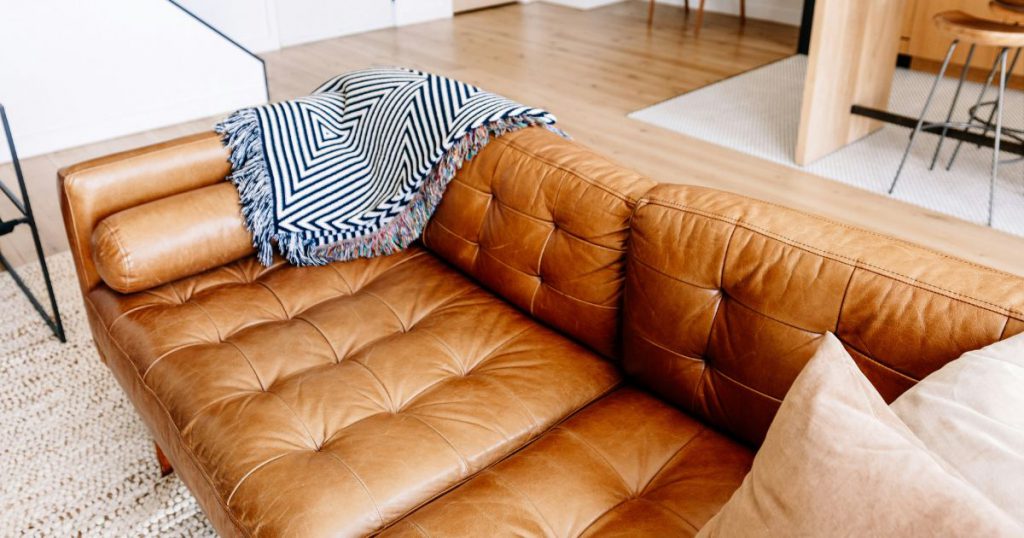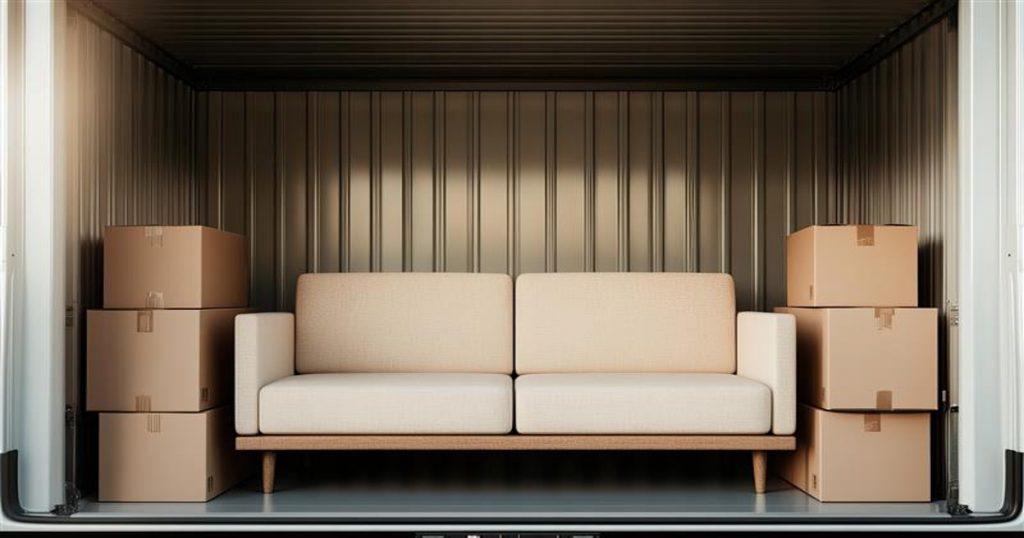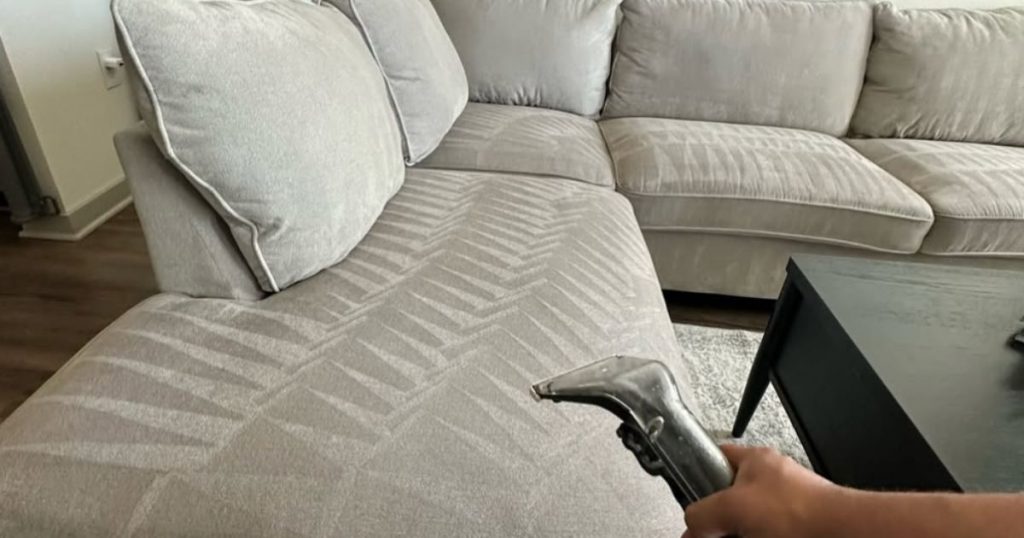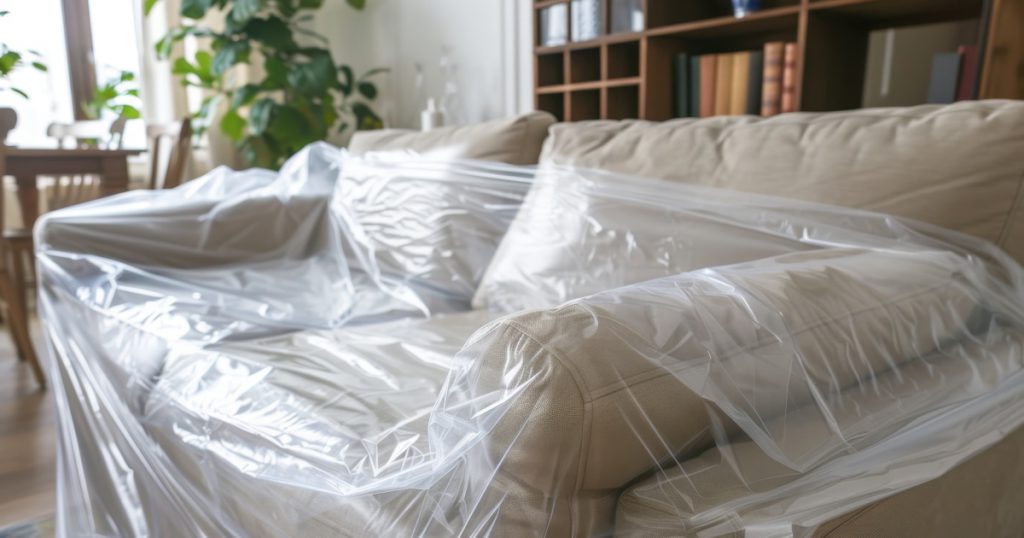
A couch or sofa is one of the most used furniture pieces in a home, so when you’re storing one, you want to make sure to do it right. Knowing how to store a couch in a storage unit and how to wrap a couch for storage helps it stay clean and ready for wherever life takes it next.
This guide walks through each step, including cleaning, disassembling, wrapping, moving, and loading it in the unit. The goal is to make the process as simple and manageable as possible.
How to Store a Couch in a Storage Unit Step by Step

A storage unit offers a convenient place to keep furniture during life transitions. It’s a common temporary solution for those who don’t have space for a couch.
But how you store your couch can make a big difference. With a few simple steps, your couch can stay comfortable and ready to use again when you need it.
1. Clean the Couch

Cleaning removes dust, crumbs, and stains that can settle deeper while the couch sits in storage. A quick refresh now can help keep it in good shape for when you bring it back home.
Depending on the type of couch, the cleaning steps will look a little different:
Leather and Faux Leather Couches
- Wipe the surface with a slightly damp microfiber cloth to remove dust and dirt.
- Use a leather-safe cleaner or mild soap solution for spots.
- Condition genuine leather to help maintain softness.
- Let every surface dry fully before wrapping.
Fabric and Microfiber Couches
- Vacuum all sides, including cushions and crevices.
- Spot-clean using a fabric-safe cleaner based on the couch’s care tag (W, S, SW, or X).
- For a deeper clean, run a handheld upholstery steamer over cushions and arms.
- Allow plenty of time to air-dry—moisture can cause odors in storage.
Velvet or Suede-Like Upholstery
- Use a soft-bristle attachment to lift dust gently.
- Spot-clean carefully with a cleaner designed for delicate fabrics.
- Steam lightly, if recommended by the manufacturer.
- Brush fibers in one direction to keep a smooth look as it dries.
Wood or Metal Accents
- Dust with a dry microfiber cloth.
- Wipe down with a gentle cleaner appropriate for the surface.
- Be sure no moisture remains before wrapping.
Remember: Drying thoroughly is very important. You don’t want to trap moisture before you wrap your couch.
2. Disassemble the Couch If Needed
Sectional couches take up a lot of room. Separating the pieces can make moving easier and give you more flexibility in the storage unit. Take the following steps to do it right, referring to the instructional manual if you still have it. A little organization now makes reassembly much easier later, with no mystery hardware or mismatched cushions to worry about.
- Separate the Sections: Unclip or unhook the connectors that keep each piece together. Pull each section apart carefully to avoid bending frames or scratching the floor.
- Remove Cushions and Pillows: Remove all loose cushions and store them separately, placing them in breathable bags or wrapping them in moving blankets.
- Remove Legs or Other Removable Parts: Unscrew legs or brackets if they come off easily, then place the screws and hardware in a small, labeled bag. Tape the bag securely to the underside of one couch piece, so that nothing gets lost.
- Wrap Each Section Individually: With everything removed and separated, it’s time to wrap smaller pieces. This creates a cleaner fit in the unit and reduces the risk of rubbing or scuffs while moving.
3. Take Measurements and Make a Plan
Measure the couch’s length, width, and height, along with doorways, halls, and elevators. Then map your route, clear the path, and use moving blankets to cover walls if needed.
4. Wrap the Couch

To keep your couch in the best possible condition, don’t just cover it while it’s in storage. Wrap it completely for maximum protection.
Wrapping your couch correctly helps your couch stay clean and avoid damage while it’s being moved in and out of the storage unit.
How to Wrap a Couch for Storage
The materials you choose for how to wrap furniture depend on the type of furniture and how long you plan to store it. Here are some guidelines to help you pick the best wrapping materials for your couch, along with steps for using them.
Breathable Covers
Using a fabric couch cover or a large cotton sheet is ideal for longer storage periods compared to plastic wrap, as it promotes airflow. During transport, it’s best to add moving blankets and stretch wrap on top of the cover to reduce the risk of damage.
Moving Blankets
Moving blankets may help to protect furniture from physical damage during transport or storage, thanks to their thickness and padding. When using moving blankets:
- Wrap the entire couch to add a soft layer against bumps.
- Secure the blankets with packing tape or stretch wrap around the outside.
- Leave space for air to circulate.
Stretch Wrap (Plastic Wrap)
Plastic wrap is best used over moving blankets rather than directly on upholstery. It helps keep the blankets in place and provides extra protection against spills or dust.
Avoid wrapping plastic directly on leather or fabric, especially for long-term storage, as it can cause discoloration.
Bubble Wrap
Bubble wrap is commonly used to pad corners and delicate parts. Follow these steps for bubble-wrapping a couch:
- Place bubble wrap over sharp edges or decorative legs.
- Add cardboard around corners for extra cushioning if needed.
- Tape it lightly so you don’t damage the finish.
How to Wrap a Leather Couch
Leather couches need some extra care before going into storage. Here are some special considerations to keep in mind:
- Wrap the leather only after thoroughly conditioning and drying.
- Allow air to circulate—leather needs room to breathe.
- Avoid sealing leather tightly in plastic for long periods.
5. Move the Couch
How you move a couch depends on your unique situation. The type and size of the couch, along with your home and storage layout, all play a role.
Here are some general tips to follow:
- Line Up Help and Gather Gear: A second set of hands makes things a lot easier. Professional hourly movers are experienced and can also be a huge help. Gather furniture sliders, furniture straps, a furniture dolly, and moving blankets.
- Remember to Lift Correctly: Proper lifting is important when moving a couch.
- Use Furniture Sliders: Place sliders under each leg or edge, then glide the couch across floors without lifting or scratching. Add furniture straps for more control and better balance.
- Roll with a Furniture Dolly: Load the couch onto a dolly for longer distances, strapping it in place so it doesn’t shift.
- Navigate Carefully: Keep walkways open, clear corners slowly, and take your time around doorways and stairs.
Couch Storage Tips
A little care now and utilizing these tips for moving heavy furniture may help your couch stay in the best condition possible while in storage:
Choose the Right Orientation
- Keep the couch in its natural upright position.
- Avoid storing it on its side for long periods, as frames can shift under weight.
- Leave space around the couch to prevent dents or pressure marks.
Keep Heavy Items Off
- Avoid stacking boxes or bins directly on the couch. Even light pressure can leave impressions over time.
- Store cushions separately or upright to maintain shape.
Elevate if Needed
- Place the couch on pallets or furniture blocks to improve air flow underneath.
Consider Climate-Controlled Storage
Climate-controlled storage units keep your belongings at a reasonably managed temperature range, making them useful for leather, wood trim, and velvet couches, especially when storing long-term and in hot and humid climates. *
FAQs: How to Store a Couch
Here are some common questions and answers about couch storage.
How long can a couch stay in storage?
A couch can stay in storage for months or even years when it’s properly cleaned, wrapped, and stored in the right type of unit. Climate-controlled storage is a great solution for couch storage.*
Should I cover my couch in storage?
It’s a good idea to cover a couch in storage. A cover adds a helpful layer against dust and damage. Use breathable materials for fabric couches and avoid placing plastic directly on the upholstery. Ideally, wrap the couch in plastic wrap over moving blankets, allowing airflow.
Ready to Store a Couch?
Proper planning and preparation can help you give your couch a good home in storage until you need it again. Make the process as successful as possible with the couch storage tips above.
CubeSmart offers a range of furniture storage options, including units with climate control. Find a CubeSmart storage facility near you to explore available unit sizes and amenities.
*Storage unit sizes are approximate and subject to availability. Temperature and humidity levels within any storage space, including climate-controlled spaces, may vary.




